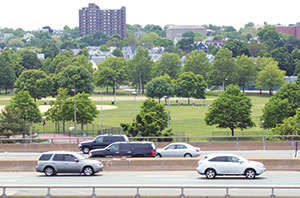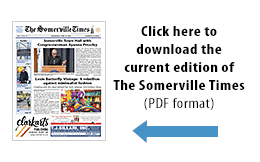
The Tufts CAFEH study offers new insights in to ways of minimizing health risks caused by pollution generated on our roadways.
By Jason Andrew Park
In a new report titled Improving Health in Communities Near Highways, researchers and key stakeholders from various institutions highlighted potential solutions to reduce traffic-related air pollution exposure in Boston and Somerville.
The report, published earlier this March, was part of a larger series of research projects called the Community Assessment of Freeway Expert and Health or CAFEH. The project actively involved the participation of various entities, including researchers, health experts, students, and community residents in order to study the adverse health impacts of air pollution near highways and major roadways in the Greater Boston area.
Improving Health in Communities Near Highways, in particular, highlights various ideas for both urban designers and policymakers to consider when aiming to reduce community residents’ exposure to traffic-related air pollution in building and development projects. According to the report, exposure to various traffic pollutants, such as fine particulate matter, has been linked to heart disease, lung cancer, asthma, and lung function.
“The report is about our efforts to translate what we know about this issue into policy and practice,” said Doug Brugge, PhD, Professor in the Department of Public Health and Community Medicine at Tufts University School of Medicine. Brugge authored the report’s section on understanding the health effects of air pollution and was also actively involved as one of the project’s key participants.
A significant part of the report focuses the results of an “expert elicitation” charrette – or a planning exercise – that engaged a multidisciplinary group of experts over a 2-day meeting to discuss solutions to minimize the negative health effects of near-roadway and near-highway air pollution for two communities, one in Boston’s Chinatown area and the other one in Somerville. This group of experts consisted of researchers, urban design planners, community members, and architects.
The Somerville site, in particular, is located near the intersection of I-93 and Route 28, which runs along the northeast edge of the site. Those participating in the charette created strategies to reduce pollution at the Somerville site by addressing not just the site of interest but also the greater surrounding area.
The public health impacts that highways have on current and future Somerville residents are concerning since major highways cross through Somerville. Therefore, this new report aims to educate the broader public on the current efforts to mitigate the burden of traffic pollution in Somerville and the changes that need to be made.
The new report concludes by introducing 11 strategies to reduce community members’ exposure to traffic pollution and reduce their risk of adverse health effects. These strategies range from reducing the noise from traffic or soundproofing to installing land use buffers to separate sources of air pollution to neighborhoods, schools, playgrounds, and other publicly used spaces.
Brugge said that he hopes the report “will help raise awareness of this issue especially among planners, designers, and policy people, so that they begin to take into consideration the nearby vehicle pollution that is in their design and urban planning.”















Reader Comments